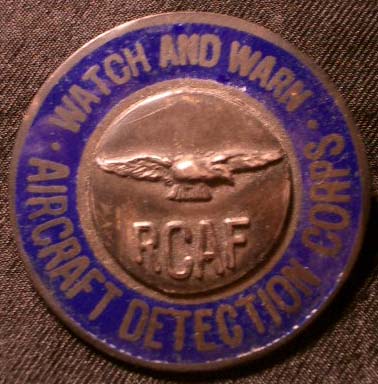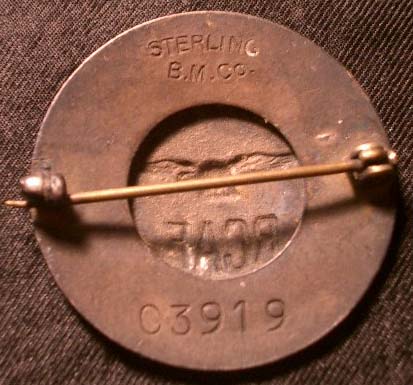

|
~SOLD~WWII RCAF AIRCRAFT DETECTION CORPS BADGE
WWII RCAF AIRCRAFT DETECTION CORPS MEMBERS BADGE
Measures 1 1/8" in diameter. Two piece construction. Blue enamel with the words AIRCRAFT DETECTION CORPS and motto "WATCH AND WARN" in silver. In the centre of the badge is an insert with the albatross and RCAF. Rear of badge is marked with maker's name B.M.Co STERLING and member's number C3919
In 1939 it would have been easy for enemy aircraft to reach Canada’s Atlantic or Pacific shores and to enter its air space without being detected. Canada had no radar alert system. To counter such possibility, the Royal Canadian Air Force (RCAF) established the Aircraft Detection Corps (ADC) in May 1940. The principle was quite straightforward and inexpensive: unpaid civilians were enlisted to monitor the air space and to warn the RCAF of any suspicious activity.
The ADC’s military personnel made sure that enough civilians were watching the skies in areas that enemy bombers or reconnaissance planes could enter. The ADC handed out documents to assist in identifying the different types of aircraft; telephone companies did their part as well by transmitting free of charge messages intended for ADC stations.
ADC observers, therefore, worked as an early warning system before a radar station network could be built. Actually an efficient air detection radar network was not set up before 1942, and its implementation not completed before 1945. Enemy air raids against Canada were so few that ADC volunteers had little opportunities to distinguish themselves. But their reports were useful to locate lost aircraft and the information they provided increased the efficiency of rescue missions.
The Air Detection Corps was divided into three regional units, placed respectively under Western Air Command (WAC), Eastern Air Command (EAC) and, in central Canada, the RCAF HQ. When it was abolished at the end of 1943, the ADC grouped some 33,000 volunteers.
Information courtesy of the Juno Beach Centre
Price: $0.00
Please contact us before ordering to confirm availability and shipping costs.
Buy now with your credit card
other ways to buy
|


